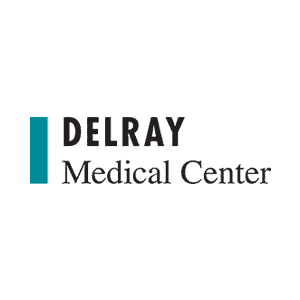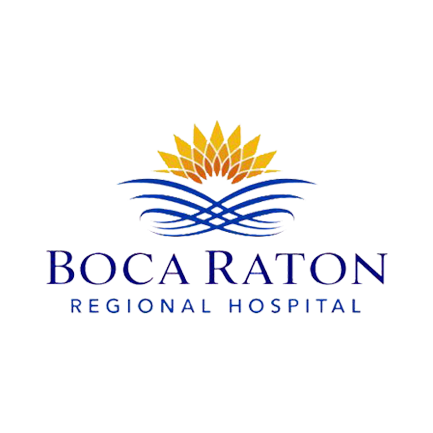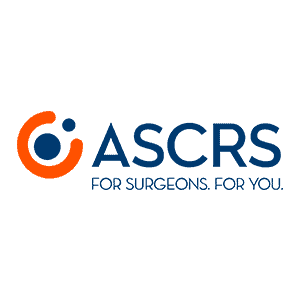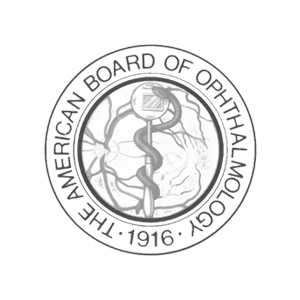Common Cataract Questions
What are cataracts?
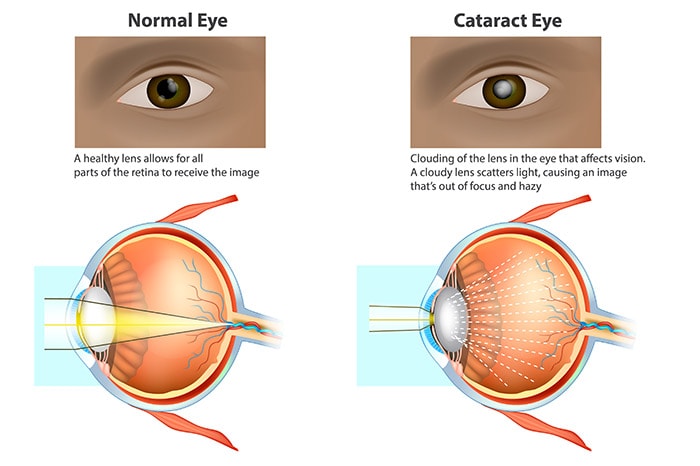 A cataract is a natural hardening and opacification of the lens inside your eye. Your lens is a clear, curved structure that lies behind your iris and pupil and changes shape to focus light on your retina, so you can see images clearly at any distance. This lens is made up mostly of water-soluble proteins, called crystallins, which are arranged in a way that allows light to pass through. As we age, the lens proteins become yellow, cloudy and inflexible blocking light from focusing properly. Cataracts could begin to develop while you’re in your 40s and 50s, a process that contributes to presbyopia or difficulty with near vision. A cataract usually starts out small with minimal symptoms (dysfunctional lens syndrome) but will mature over time causing more significant vision problems. Medications, UV exposure, ocular trauma, and other diseases can also contribute to cataract development and complicate treatment options.
A cataract is a natural hardening and opacification of the lens inside your eye. Your lens is a clear, curved structure that lies behind your iris and pupil and changes shape to focus light on your retina, so you can see images clearly at any distance. This lens is made up mostly of water-soluble proteins, called crystallins, which are arranged in a way that allows light to pass through. As we age, the lens proteins become yellow, cloudy and inflexible blocking light from focusing properly. Cataracts could begin to develop while you’re in your 40s and 50s, a process that contributes to presbyopia or difficulty with near vision. A cataract usually starts out small with minimal symptoms (dysfunctional lens syndrome) but will mature over time causing more significant vision problems. Medications, UV exposure, ocular trauma, and other diseases can also contribute to cataract development and complicate treatment options.
What are cataract symptoms?
It might not come as much of a surprise that cataracts affect your vision. Some changes you can experience include:
- Difficulty reading in low light
- Blurred or double vision
- Sensitivity to bright lights
- Gradual dulling of colors or contrast
- Halos or glare when driving
- Increase in intraocular pressure
- Fluctuations in glasses prescription
The team at Cohen Laser & Vision Center recommends coming in for an evaluation once you start noticing vision changes, as cataracts are only one cause of vision problems. Without proper and timely care, your cataract can lead to significant vision loss.
When Are Cataracts Treated?
Treating your cataract depends on how it’s affecting your vision. During the early stages of a cataract, the team at Cohen Laser & Vision Center usually recommends frequent monitoring and updating glasses prescriptions for as long as possible. As the cataract continues to grow, surgical removal will become necessary. The team at Cohen Laser & Vision Center recommends cataract surgery when your vision loss interferes with your daily activities including reading, driving, and watching TV. Once the cataract is removed, a new intraocular lens (IOL) is implanted at the same time restoring vision.
What is laser cataract surgery?
Femtosecond laser assisted cataract surgery (FLACS) is a state-of-the-art modification of conventional surgery. This special laser assists the surgeon during certain steps of the procedure, to hopefully reduce the total time and energy needed to break up and remove the cataract. The advantage of FLACS is improved safety and quicker healing times in some patients, especially those with more mature or dense cataracts. The doctors at CLVC use the Alcon LENSx and LENSAR lasers at their facilities. These advanced laser systems can also make special marks in the cornea to treat an astigmatism without the need for a toric IOL, which may reduce the total cost of the procedure. However, FLACS is not covered by insurance and is considered optional.
What can I expect during cataract surgery?
The doctors at Cohen Laser & Vision Center are skilled surgeons who utilize the most advanced tools and techniques available to perform cataract surgery. Before the procedure, the team performs a series of special tests and measurements to determine which treatment options and intraocular lens implants (IOLs) are appropriate. Cataract surgery with IOL implantation typically takes about 10-15 minutes and is performed either in-office or at a surgery center under local anesthesia. While most patients are not asleep during the procedure, the team at CLVC will ensure you are comfortable and relaxed the entire time. Most patients do not report any significant pain during or after the surgery. You will receive detailed pre- and post-operative instructions, which includes limited physical activity, wearing protective eye shields, and using medicated eye drops for several weeks after the procedure. Furthermore, the doctor will examine you closely in the days and weeks after surgery to ensure your eye is healing as expected. Some patients experience swelling, tearing, and discomfort after cataract surgery for the first few days. It can take several weeks to fully recover and achieve your final visual acuity.
How is cataract surgery performed?
Modern cataract surgery is generally a safe, quick, and painless procedure. Your surgeon will use special instruments to make small incisions through the edges of the cornea, which close naturally without the need for glue or sutures. These incisions allow the doctor to access the cataract behind the dilated iris.
Using careful maneuvers, Dr. Cohen breaks up the cataract into small fragments and aspirates the material out of the eye. Once the cataract is completely removed, a special intraocular lens (IOL) is placed into the eye to replace the natural lens and focus light properly. This artificial lens is made of a bio-compatible plastic that will remain in your eye indefinitely, but it can be removed later in very rare circumstances.
How safe is cataract surgery?
Modern cataract surgery is generally very safe. Most patients experience dramatically improved vision, both with and without glasses, compared to before the operation. However, complications can still occur.
Most patients do not experience any pain or discomfort during the procedure, but oftentimes pressure and mild irritation can be noted. Medications are given by mouth or IV to promote relaxation and ease anxiety, but generally minimal to no active sedation is used since the surgery is so quick.
Like all procedures, the risk of infection is of highest importance. Antibiotic drops and sterilization solution is used to prepare the eyes before, during, and after surgery to minimize the risk of infection. Injections can occur at any point, but generally present within the first week or two after surgery and are usually accompanied by sudden pain and vision loss. This occurrence is fortunately very, very rare and can still be managed in most cases with early treatment and close monitoring.
Other risks of cataract surgery involve damage to important anatomic structures in the eye during or after surgery, which may result in additional procedures to remove leftover cataract material or position a special type of intraocular lens. Uncontrolled inflammation can also cause vision changes and eye pain, so generally post-operative anti-inflammatory drops are used for several weeks after the procedure as well.
Patients achieve excellent results at CLVC due to the care and close supervision we provide all our patients.
What lens options are offered?
Choosing an intraocular lens is an important decision made between you and the doctor. While some patients may be limited as to what lens options are appropriate, in general there are several types of lenses to choose from with different advantages, disadvantages, and price points. It’s important to be mindful that even flawless surgery may not result in perfect outcomes, so managing expectations is critical. A brief review of some IOL offerings at CLVC are found below:
Monofocal IOL
These basic lenses offer good distance vision, but patients with a monofocal IOL will likely need prescription glasses to achieve “perfect” vision, since they do not correct for any astigmatism. They also do not provide much close-range vision (e.g. computer, phone, books) and therefore patients should expect to use reading glasses or bifocal/progressive prescription glasses. These lenses are usually covered by insurance.
Toric IOL
A toric lens is a monofocal lens, meaning it only focuses for distance, but provides a distinct advantage in that it will correct for an astigmatism as well. This allows for greater clarity and less glare when watching TV or driving. Like a monofocal lens, patients choosing a toric lens will still need reading glasses for near tasks, but generally do not need any distance prescription. Dr. Cohen will advise if this type of lens is recommended based on pre-operative measurements. This lens is not covered by insurance.
Extended-depth-of-focus (EDOF) lens
An EDOF lens can provide excellent distance vision, but also allows for clarity in intermediate distances as well (e.g. dashboard, computer, countertop). These lenses usually provide less glare than a multifocal lens (see below), but don’t focus as well up close. These are great options for athletes or those who prioritize distance vision and don’t mind over-the-counter reading glasses. Examples of EDOF lenses are the Alcon Vivity, Rayner One, and J&J Symfony. These lenses are not covered by insurance.
Multifocal IOLs (MFIOL)
These trifocal lenses are the most advanced lenses available in the US today, offering distance, astigmatism, mid-range, and close vision with minimal compromises. While they are very well-tolerated by most patients, some reports of glare or haloes around lights are more common with this type of lens. For those patients seeking near-total independence from glasses or contacts at all distances, these are likely the best options. Examples of MFIOLs include the J&J Synergy, Alcon Panoptix. These lenses are not covered by insurance.
Light-adjustable-lenses (LAL)
The new LAL technology provides unparalleled accuracy and clarity since the final prescription is adjusted after surgery. Unlike all other IOLs, which require pre-operative measurements to determine lens power, LALs can be customized after implantation which reduces variability and unforeseen refractive surprises. These lenses are implanted during cataract surgery like other IOLs, but special ultraviolet light is used to tweak the focusing power of the lenses in the office 2-4 weeks after the initial surgery. Patients must be careful to follow all post-operative restrictions and avoid UV light or else the prescription power may deviate. These lenses generally don’t give as much reading vision as multifocal IOLs and are comparable to EDOF lenses in terms of their optical performance at far and middle distances.
Currently this lens technology is not offered at CLVC. The surgeons at Cohen Laser & Vision Center will discuss your lens options with you and recommend the one that best meets your needs and goals. We are proud to offer a wide-range of excellent IOL manufacturers, and will help choose the right lens for you regardless of branding.
Can cataracts come back after surgery?
No. Once a cataract is successfully removed during cataract surgery the structure can never grow back. Instead, the replacement IOL serves the same purpose as the natural lens, providing clear and focused vision. Some people describe a “secondary cataract” as the sensation of cataract symptoms returning weeks or months after surgery. This problem is due to a posterior capsular opacification or “PCO” and is caused by residual cataract cells growing on the new lens capsule. The lens or cataract itself did not regenerate. Treatment of a PCO involves using a special YAG laser to polish off this debris. The procedure takes about 5 minutes and does not cause any discomfort or pain. Your doctor will advise if any post-surgical vision changes are due to a PCO and recommend if such a treatment is advised. While we expect a patient’s vision to remain stable after surgery for many years, subtle variations in one’s refraction may occur in some patients regardless of the type of IOL used. This may require spectacle correction or additional surgery.
Want More Information?
Contact us today so we can answer your questions.
Call us now at (561)981-8400, or request an appointment online here.






